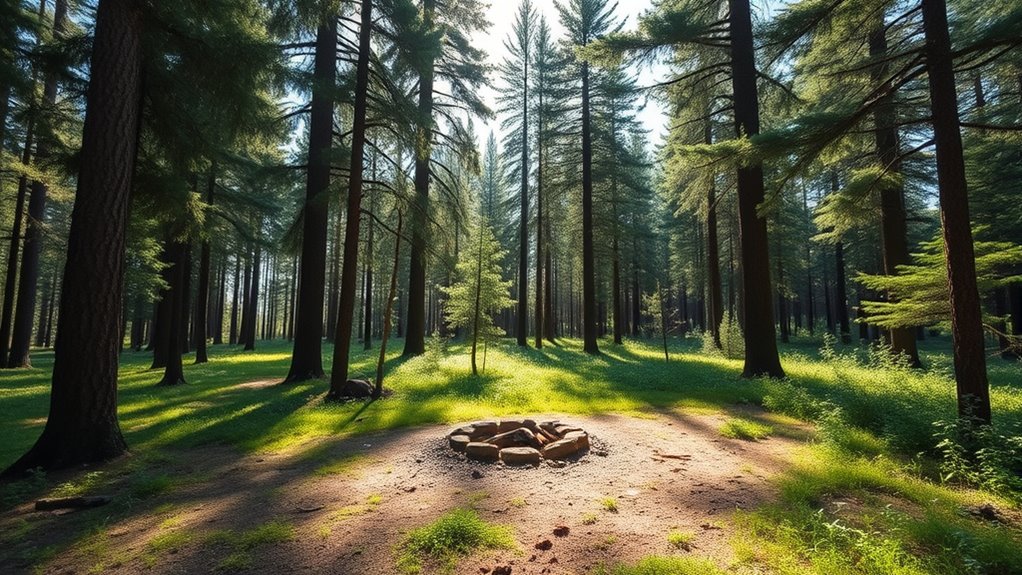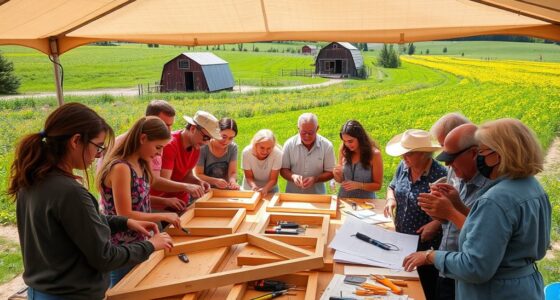To survive without leaving scars in the wilderness, follow Leave No Trace principles by preparing properly, staying on designated trails, and packing out all trash. Respect wildlife by observing from a distance, avoid feeding animals, and keep noise low. Be considerate of others by maintaining a peaceful environment and leaving areas better than you found them. Practicing these strategies helps preserve nature’s beauty—keep going to discover more ways to minimize your impact and protect the environment.
Key Takeaways
- Follow established trails and campsites to minimize environmental impact and prevent habitat damage.
- Pack out all trash and waste, including food wrappers and leftover materials, to keep the wilderness pristine.
- Respect wildlife by observing from a distance and avoiding feeding or disturbing animals.
- Use biodegradable products and proper hygiene practices to prevent contamination of water sources.
- Maintain a quiet, considerate presence to preserve the peaceful environment for all visitors and wildlife.

When you spend time outdoors, practicing Leave No Trace principles guarantees that nature remains pristine for everyone. It’s about more than just following rules; it’s about respecting the environment so that future generations can enjoy the same beauty you do today. As you venture into forests, mountains, or parks, keep in mind that your actions can leave an impact—either positive or negative. By consciously minimizing your footprint, you help preserve the wilderness’s natural state, ensuring it stays vibrant and healthy.
One of the most important aspects of Leave No Trace is planning ahead. Before you set out, research the area, understand the regulations, and prepare accordingly. This helps you avoid unintended damage, such as creating new trails or disturbing sensitive habitats. When you arrive at your destination, stay on designated trails and campsites, which reduces soil erosion and protects plant life. Wandering off-trail might seem harmless, but it can damage fragile ecosystems that take years to recover. Additionally, checking the operating hours of local parks and attractions can help you plan your visit during less crowded times, reducing environmental stress.
Plan ahead and stay on designated trails to protect fragile ecosystems and preserve natural beauty.
Disposing of waste properly is crucial. You should pack out everything you bring in, including food wrappers, bottles, and trash. If you encounter waste left by others, do your part by removing it and disposing of it responsibly. When nature calls, use established restrooms if available; if not, dig a cathole at least 200 feet from water sources, ensuring it’s deep enough to prevent contamination. Always carry a trowel and biodegradable soap to minimize environmental impact during personal hygiene routines.
Respect wildlife by observing from a distance and avoiding direct contact. Feeding animals disrupts their natural behaviors, making them reliant on humans and potentially dangerous. Instead, enjoy watching them quietly and let them go about their routines undisturbed. Remember, your presence can cause stress or displacement, so keep noise levels low and avoid startling animals with sudden movements.
Finally, be considerate of other outdoor enthusiasts. Keep noise to a minimum, share the space amicably, and leave everything as you found it—or better. If everyone adopts these principles, the wilderness remains unspoiled for everyone to enjoy. Practicing Leave No Trace isn’t just about avoiding fines or penalties; it’s about embodying a mindset of stewardship and respect. When you leave no trace behind, you leave a legacy of conservation and care, ensuring that nature’s treasures endure for generations to come.
Frequently Asked Questions
How Can I Teach Children About Leave No Trace Principles Effectively?
You can teach children about Leave No Trace principles by making lessons fun and interactive. Use stories, games, and hands-on activities to demonstrate how to minimize impact on nature. Show them real-life examples and encourage questions to foster understanding. Lead by example, practicing these principles yourself. Keep lessons short and engaging, and praise their efforts to instill a sense of responsibility and respect for the environment.
What Are Common Mistakes to Avoid When Practicing Leave No Trace?
You should avoid overusing fire, which can cause lasting damage, and don’t leave trash behind—always pack out what you bring in. Be careful not to disturb wildlife or their habitats, and stay on designated trails to prevent erosion. Avoid making new fire rings or carving into trees, as these scars harm the environment. Ultimately, don’t take natural objects like rocks or plants, preserving the area’s natural beauty.
How Does Leave No Trace Apply to Urban or Park Settings?
In urban or park settings, you apply leave no trace by staying on designated paths, disposing of waste properly, and avoiding damage to plants and structures. You should pack out all trash, minimize noise, and respect wildlife and other visitors. By being mindful of your footprint and leaving areas as you found them, you help preserve these spaces for others, ensuring they remain beautiful and accessible for future enjoyment.
Can Leave No Trace Principles Be Adapted for Emergency Survival Situations?
Yes, you can adapt Leave No Trace principles for emergency survival. Focus on minimizing your impact by conserving resources, such as water and firewood, and avoiding unnecessary damage to the environment. Practice responsible waste disposal, like packing out trash, and respect wildlife. In emergencies, balance survival needs with environmental care, ensuring you leave as little trace as possible while prioritizing safety and efficiency.
What Are the Environmental Impacts of Ignoring Leave No Trace Guidelines?
Ignoring Leave No Trace guidelines can silently but severely damage the environment. You risk disturbing wildlife, causing soil erosion, and leaving behind scars that mar natural beauty. These actions can lead to long-term ecological harm, making areas less hospitable for future visitors and animals alike. By neglecting these principles, you unknowingly contribute to the degradation of pristine wilderness, turning once vibrant spaces into fragile, scarred landscapes that may never heal fully.
Conclusion
So, you set out to leave no trace, aiming for purity in your survival. Ironically, in trying to escape your scars, you might just carve new ones, invisible yet permanent, on your soul. The more you endeavor to erase your past, the more it lingers, shaping who you are. Perhaps the real lesson is that some marks are unavoidable—and maybe, just maybe, leaving no trace isn’t about erasing, but embracing every scar you carry.










